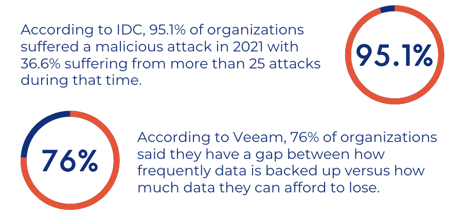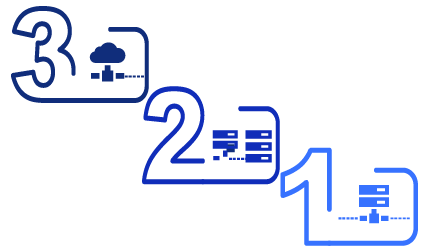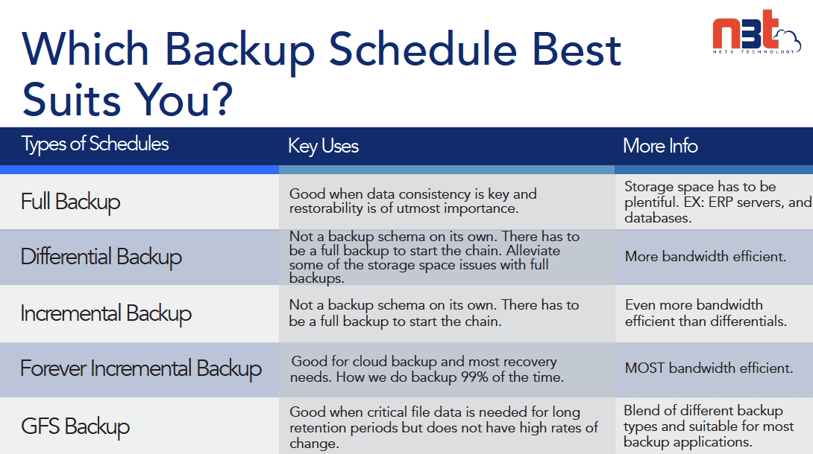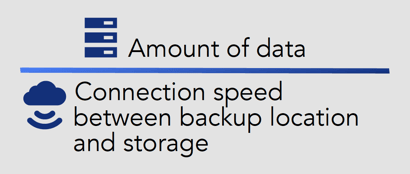The Ultimate Guide to Successful Cloud Backup
How to ensure complete data protection, avoid common mistakes, compare on premise backup, and find the best solution for your business.
Data loss results in both tangible damages (such as financial) and intangible damages (such as reputation) to your business. The only way to protect your business from losing essential data is by backing up that data regularly and consistently.
Unfortunately, it is no longer IF your business will face a disaster event, but WHEN your business will face a disaster event. Not having a backup puts your most valuable asset, data, at risk. With data loss being the result of ransomware, simple human error, or a natural disaster - here is why your business is at risk no matter what:

Not only will having a backup decrease your risk of data loss, but it will also help drive your business goals. Research shows that 92% of organizations currently host their IT environment in the cloud with the goal of increased flexibility, productivity, and reduced costs.
The cloud offers many benefits for organizations to take advantage of, but how can you ensure your cloud backup is successful? Knowing these statistics can be intimidating at first and it can be difficult to determine the best place to start, we have created this guide to help ensure your backup is successful for complete data protection.
What are the Biggest Backup Mistakes to Avoid?
Before you start backing up to the cloud, you need to make sure you understand your environment completely - which allows you to define a backup plan to cover all your bases for a successful recovery. This can be done through our comprehensive backup checklist:
- Discovery: Understand your environment completely and determine which applications are being used, where data is located, what technologies are present in the environment, etc.
- Definition: Define the applications and data that need to be addressed in your backup plan; what applications are customer facing/internal facing, how long does data need to be kept, what are the policy requirements, etc.
- Scoping: Scope each application to a product - backup, replication, or hybrid?
- Implementation: A guided implementation may help ease the complications that could arise during implementation as there are certain actions that should be tested and covered during this phase.
- Auditing and testing: A good audit and testing plan should be put into place to ensure your backup plan is efficient and effective.
The importance of having a backup cannot be overstated. However, there are quite a few mistakes that can lead to backup failure. We have compiled a list of 7 common backup practices that should be avoided, as they often result in backup failure.
- File Sync is my backup:
While it is true that file sync automatically copies your changes to synchronized files and it is nice to have an automated second copy utilizing Microsoft OneDrive or Google Drive, this is not a backup replacement. If a file or folder is infected with ransomware, it will automatically be copied to all synced versions of that file - leaving you with only compromised versions. - You only need to backup your data (files, folders, documents):
Though backing up changed data of files and documents reduces storage space and recovery time and saves money - it is just as important to make sure business systems are backed up as well. In the event of a system failure, what good is a file and document recovery when there is no system for them to go to? The recovery time in this scenario would be long since you would essentially need to build a replacement system. Before anything is recovered, you would need to reinstall an OS, any required applications and reconfigure the environment. Having a full system or VM backup enables you to be up and running much faster. - Having multiple backup copies guarantees success:
The 3-2-1 backup rule is a great place to start for successful backups. But what good are the copies of your data if you aren't testing the recovery of your backups on a regular basis? Do they work properly after coming back online or are they still susceptible to user error or data corruption? Make it a habit to test your backups regularly or have an outsourced provider do it for you. - Data backup and disaster recovery are the same:
Many people do not understand the difference between data backup and disaster recovery. Disaster recovery refers to replicated data, not the snapshotting of data with a backup. This replication of data is granular - going back to the action point in time (within 10 seconds) before the data was compromised. Backups do not have this capability as they are done with snapshots. Bringing backups back online is a manual process and could take days - which is not a bad thing for applications that aren't critical to business operations. But for the systems and applications that do need to come online quickly, they need to have a proper disaster recovery product installed. To learn more about backup and replication, scroll down. - A local backup is all you need:
Only having a backup on prem is not going to save your business in todays threat landscape. There are too many outside variables and room for human error to depend on one local backup. If you have not already implemented the 3-2-1 backup rule, it is time to do so. - Backups are safe from malware and ransomware:
Nothing is guaranteed safe these days. Unfortunately, malware and ransomware can now infiltrate your backups. The remedy to this issue is to literally give your network some space, called air-gapping. An air-gapped backup is the physical separation of the backup from your network. To add an additional layer of security, be sure to use different authentications when logging in. - Cloud backup is not safe:
When the cloud first came to the backup scene, there were many concerns regarding its security and safety. But over the years, it has proven to be a very good safety net for backups. A good cloud provider can encrypt your data while in transit and at rest. Remember, if data is only stored in one place and that single place gets destroyed, the data is lost forever. Whereas data in the cloud replicates across multiple servers and can be recovered.
Watch out for these common backup mistakes that can easily be avoided:
The list of assumptions and mistakes to avoid are not to scare you - they are simply to help you become more aware of mistakes others have made that have resulted in catastrophic data loss, causing financial damage to their company. Keep these in mind while crafting your complete backup plan.
Cloud Backup vs. Do it Yourself
If implemented and managed correctly, cloud backup has the potential to offer cost savings, agility, and a competitive advantage. So what are the main differences between cloud backup and doing it yourself? The biggest piece is that with cloud backup - you don't have to buy additional storage or colocation, you eliminate equipment costs, and are left with highly available infrastructure. Ideally, organizations would have an on premises backup and then replicate it to the cloud - we DON'T recommend for organizations to only have on premises backup and colocation backup. Let's look at the benefits of cloud backup:
For cloud backup, resources are hosted in the cloud, by a cloud services provider. Traditionally, the cloud offers a more affordable, stable, monthly cost with low maintenance expenses, low capital expenditure, and no additional equipment cost.
For 'Do it Yourself', resources are deployed in house and within an internal IT infrastructure. Typically, there is an increased staffing cost to maintain machines, a high capital expenditure, high maintenance cost, and additional equipment costs.
- Infrastructure Costs: Infrastructure costs typically include hardware/software, backup software, networks, monitoring tools, the cost for providing power and the value of real estate where it resides. With cloud backup, you don't have to buy additional storage or colocation and you eliminate equipment costs.
- Overhead & Maintenance: It takes a village to implement, develop, and maintain 'Do it Yourself' backup. With cloud backup, a cloud services provider takes all of the infrastructure you would typically have on premises and manage it in the cloud for you.
- Internet Bandwidth: For cloud backup, you only need internet bandwidth, there is no need for two high bandwidth circuits.
- Accessibility: With cloud backup, your data is accessible from anywhere - without complicated networking.
- Storage: Cloud backup has no limits to how much can be stored, your cloud storage grows as your business grows. You can scale your resources any time of the day, any day of the year, for any reason. Not only that, but your cost also directly reflects the customized environment that you have created in the cloud.
What is the 3-2-1 Backup Rule?
To ensure your data protection strategy is prepared for an efficient recovery, you should deploy the 3-2-1 backup rule. The backup rule is simple - you should have 3 copies of your data, one primary copy and two backup copies. You should also have 2 types of storage mediums - local drive, NAS device, tape drive, etc. Lastly, you should have 1 copy stored offsite - in the cloud, secondary on prem site/co-location.
Having this backup rule in place will help save your data in the event of ransomware, natural disaster, faulty equipment, human error, or whatever disaster event ruins your one and only copy of data. If you do not have a backup copy stored off site - you are putting your data at risk of being lost. Be prepared by implementing the 3-2-1 rule as losing data can be catastrophic to a business.

Types of Backup Schedules
For your backups to offer your business any value, they need to be performed regularly and consistently. Having someone manually perform backups can be inefficient, a more effective approach is to schedule your backups to automatically complete - ensuring completion. However, backup schedules are different for every business that adapt to individual business needs over the course of time. Here are the main types of backup schedules or schemas to help guide you on what to consider:

A Full Backup contains all the data for a single machine and provides a starting point for all the other backups. A single backup provides the ability to completely restore all blocks of data from the point in time it was taken. All the backed-up data is contained in a single restore point. Because we touch every block of data, full backups are the slowest backups to finish and the storage space required is the largest compared to differential and incremental.
A Differential Backup will copy all changed data since the last full backup, duplicate data will NOT be backed up. An advantage of differential backups is that when data needs to be restored, it can be built from the last full backup and the last differential copy. However, since the size of the backup increases each time one is taken, the backup window duration and storage space needed are both increased.
An Incremental Backup provides a faster way of backing up data instead of consistently conducting full backups. The advantages of incremental backups include that they are the fastest backups, less storage space is needed, and you get a shorter backup window on days between full backups. A disadvantage of incremental backups is that a full restore can be slower than other backups since you will need both the full backup and all increments since.
A Forever Incremental, or Always Incremental, is a modification of the incremental method that attempts to combine the ease of recovery in a full backup and the efficiency of an incremental. Certain backup products such as Acronis and Veeam can create metadata that allows the backup to be restored from a single point and rolled into the initial full backup for a complete restore. This is accomplished by keeping a chain of backups within a single archive file.
A GFS (Grandfather, Father, Son) Backup schema attempts to increase backup efficiency while still getting a frequent full backup. This schedule shortens the chain of backup but allows for relatively quick recovery times. It is a more complicated schedule to get implemented, but for risk averse organizations that are also seeing long backup times, this can be advantageous. Typically, this is done on a schedule like this:
- 1st day of the month - Full Backup is taken
- 1st day of each week - Differential Backup is taken
- Every day of the week - Incremental Backup is taken
After deciding which backup schedule is best for your business needs, you may be wondering what time you can start your backup so that it ends at an appropriate time, without impacting backup users? This is called your backup window. Your backup window can be calculated by taking the amount of data to be backed up and dividing it by the speed of connection between the backup location and the storage. Be sure to factor in current utilization of the network path and overhead for backup protocols.
The simplest answer to "How often should I backup my data?" is to backup regularly and as often as necessary to decrease the impact of data loss. Any of the above backup schedules are valid and will protect your data. However, backup schedules should be dependent entirely on the needs of your organization and the amount of risk that can be tolerated. See how much an outage would cost your organization with our downtime calculator. Ransomware attacks, power outages, natural disasters, and simple human error are all common reasons for data loss. The only real way to protect your business from losing critical data and the after affects associated, is to backup your data.
What is the Difference Between Backup and Replication?
It is important to understand the difference between backup and replication - as many people seem to get the two confused and think they are the same thing. Questions may arise such as, "Does the company need backup, or does it need replication?" "Would it benefit to have both?". Both are valid questions so let's begin with a simple definition and their respected pros and cons.
A backup is a point in time copy of the production environment that is stored in an archive. Backup files can be compressed to save space and exist on slower, cheaper, commodity storage. Another pro of backups is that the files can be recovered for as long as you wish to retain the archive. However, backup operations can consume large amount of bandwidth and utilize storage resources to accomplish the task. Furthermore, the amount of change data that must be processed and archived is larger.
Replication is a near real-time copy of the production environment that is stored in the format as the original environment. Replication reduces the time it takes to bring the production environment back online and the copies are much more recent than point in time backup. Unfortunately, data is typically stored on expensive production storage. Another con of replication is that the data is much more susceptible to corruption because it is near real-time and before it is noticed in the environment
Another key difference between backups and replication is their response to data loss. For backups, you can retrieve your data from the last backup you took. For replication, you can retrieve your data almost instantly from the point of data loss. Let's explain this more in depth:
For backups, most companies typically perform a daily backup, therefore you can restore data from the previous day. Between the time that the backup was performed and the data loss "event", there may be new data that is lost and unable to be recovered. Data recovery from a backup is much slower process than replication fail over. Backups are copied and stored in archive format that is only understood by the backup application and must be translated to a usable form. Those archives are usually on much slower storage and can take hours to copy into the product storage and be of any use.
For replication, the software is continuously copying/mirroring your data in a way that is directly understood by your environment (database, email server, etc.). No translation is needed as it is for backups. Restoring your environment takes seconds to minutes, depending on your data protection set up. Ransomware, damaged databases, and malicious actions can replicate to your recovery environment just like the good data. If it is not caught in time, a recovery to a point in time backup may be necessary.
So you may be wondering, do you need backup and replication together? That solely depends on how you want your business to operate in the event of data loss. All applications may not need to have real time replications but just having a backup copy for all applications may not be enough. Determining the value of your applications to your business is key when choosing how to proceed in protection of your business' data. A popular option is to backup the entire environment but layer real time replication onto your critical applications.
Best Backup Software
Determining the best backup software for your business and individual business needs can be difficult due to the abundance of options on the market today. One of the most common questions asked is, "Which backup product do I choose?" and we answer by posing the question back to them, "What do you want to accomplish with your backup product and disaster recovery plan?". We have already done our research and testing to narrow the field to products that offer secure, reliable recovery at reasonable price points.
We do not recommend solely having an onsite backup for your backup location - it is a huge risk. We highly recommend using the cloud for your offsite, second location. If you are still unsure if the cloud is right for your business, read our blog on why the cloud is a good option.
There are 2 great products that cover a variety of environments and offer a wide range of recovery options - Acronis and Veeam. These products offer you granular recovery for files and folders while also handling mission critical applications such as O365, Exchange, SharePoint, and SQL. These products are very user friendly and easy to set up, utilize, manage, and restore your environment with. Here are our favorite features of each of the products:
Acronis Cyber Protect Cloud protects data on 20+ platforms with the ability to do both on-site and cloud backup, at the same time. Acronis Cyber Protect Cloud is secure, customizable, offers easy recovery, and a wide range of recovery options. Download Acronis' solution brief to learn more and read this case study to see how Metalworks, Inc. reduced spending and risk by choosing Acronis powered by Net3 Technology.
Veeam is a robust solution that offers fast and flexible recovery for any size environment. From the enterprise to SMBs, Veeam's "always on" approach to data protection has proven to be reliable. Highlights of Veeam include being robust, secure, offering fast recovery, and their wide selection of recovery options. With 80% of Fortune 500 companies using Veeam as their backup solution, it is a great option. Read more in our solution brief.
If your business is looking for a product that provides data replication, we recommend Zerto. Zerto is based on continuous data protection (CDP) with near synchronous replication and unique journaling technology enables organizations to recover from any disruption, including ransomware, outages and more, with the lowest recovery point objectives (RPOs) and fastest recovery time objectives (RTOs) in the industry, dramatically limiting data loss and downtime. This case study highlights how Crown Laboratories protected their business from data loss and downtime from Hurricane Helene, utilizing Zerto with Net3 Technology.
Ready to Protect Your Data?
Contact us today for pricing, a demo, or more information!
Net3 Technology is a Cloud Services provider that partners with companies to provide cost effective Backup, Disaster Recovery and Cloud Production services across the United States. Our goal is to understand business environments to ensure complete data protection and cloud confidence.
